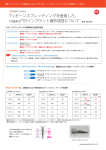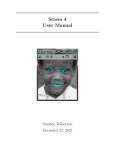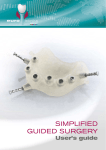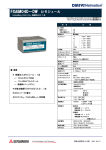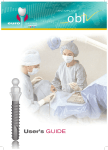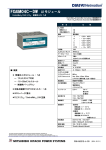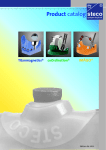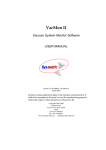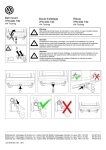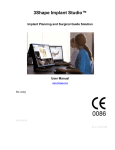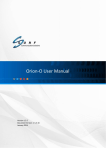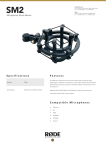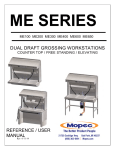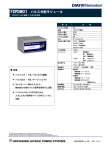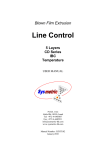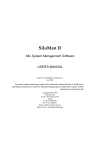Download USER MANUAL: DENTAL IMPLANT SYSTEMS
Transcript
USER MANUAL: DENTAL IMPLANT SYSTEMS Contents 1. ADIN Dental Implant Systems Products 3 1.1 ADIN Dental Implant Systems Description 3 1.2 ADIN Dental Implants Intended Use 3 1.3 ADIN Dental Implants Contraindications 3 1.4 Preoperative Considerations and Precautions 3 1.5 Intraoperative Considerations and Precautions 3 1.6 Prosthetics Considerations and Precautions 4 1.7 Implant Packaging 4 1.8 Product Sterility and Maintenance 4 1.9 Product Training and Education 4 1.10 General Warnings 4 2. Surgical Procedures 5 2.1 Examination and Treatment Planning 5 2.2 Bone Quality 5 2.3 Vertical Bone Quantity 5 2.4 Horizontal Bone Quantity 5 2.5 Implant Insertion 5 2.6 The Flapless Technique 5 3. Drilling Protocol 6 3.1 Drills Description and Properties 6 3.2 Drills Intended Use 6 3.3 Depth Measurement System 6 3.4 Depth of Drilled Site 6 3.5 Step-by-Step Clinical Procedure 6 3.6 Drills Cautions and Warnings 7 -2- 1. Adin Dental Implant Systems products 1.1 ADIN Dental Implant Systems Description: • Routine treatment is not recommended for under-aged children until growth has stopped and epiphyseal closure has occurred. ADIN Dental Implant Systems Ltd. designs and manufactures technologically advanced dental implants solutions. ADIN’s dental implant system includes Implants, abutments, associated restorative and dental laboratory components, instruments and accessories. • If the above contraindications accommodations should be considered. exist, special Note: Please refer to appropriate clinical manuals and textbooks for information about treatment planning and medical evaluation. The dental implant systems include the lines listed below: Swell™ Touareg™ Touareg™-S Touareg™-OS Touareg CloseFit™ Triple™ One™ 1.4 Preoperative Considerations and Precautions: • Prior to any surgical procedure, a comprehensive patient evaluation is necessary in order to determine factors that may put the patient at risk, due to the implantation procedure itself, or factors that may affect the healing process of either the bone and/or the soft tissue. • Patients must be carefully examined and evaluated to determine proper radiographic, psychological and physical status. 1.2 ADIN Dental Implants Intended Use: ADIN dental implants are intended for surgical placement in the maxillary and/or mandibular arch, to support crowns, bridges, or overdentures, in edentulous or partially edentulous patients. Restorations range from a single tooth restoration to a full mouth restoration. ADIN dental implants may be immediately loaded when good primary stability is achieved and with appropriate occlusal loading. • Patient’s teeth and any associated bone or soft tissue deficits that can influence final results should also be evaluated. • Constant communication and cooperation between the dental surgeon, the restorative dentist and dental laboratory technician is essential to achieve desired success. • The use of improper techniques in either the implant placement or restoration process can result in implant failure and a substantial loss of surrounding bone. 1.3 ADIN Dental Implants Contraindications: • Dental implants should not be used in patients who are considered medically unfit for general oral surgical procedures. • Do not reuse implants, cover screws, temporary abutments and abutments. Reusing these items may lead to increased risk for product failure and/or contamination, as functionality cannot be guaranteed. • Patients who exhibit underlying factors that might affect the healing process of either the bone or the soft tissue (e.g., connective tissue disorder, steroid treatments, bone infections, cigarette smoking), should carefully evaluate the potential risks and benefits associated with the recommended treatment. • Sufficient residual bone volume is necessary in order to achieve high primary and secondary implant stability, for the implant to be able to handle prosthetic rehabilitation. In cases of inadequate bone volume, certain bone augmentation procedures should be considered. • The use of wrong implant sizes, insufficient amount of implants and/or improper implant positioning for prosthetic rehabilitation, may lead to mechanical failures, such as fatigue fractures in the implants, prosthetic and/or abutment screws. 1.5 Intraoperative Considerations and Precautions: • All efforts must be made to minimize damage to the host tissue, paying special attention to thermal and surgical trauma, and to the elimination of contaminants and sources of infection. • Inadequate volume and/or quality of remaining bone or soft tissue, infections and general diseases, may result in compromised esthetic results or unfavorable implant angulation, and cause osseointegration failure, both immediately after surgery, or after osseointegration is initially achieved. • Implantation surgical procedures require a high degree of precision and care. The limits for acceptable tissue handling are much narrower in implantation than in general oral surgery. Any divergence from the surgical plan during implant placement increases the risk of osseointegration failure. • Extra precaution should be taken when implanting a narrow platform internal hex implant in the posterior region. • Implant placement and prosthetic design must accommodate each individual patient’s conditions, such as bruxism or unfavorable jaw conditions, in order to reduce the risk of implant overload or fatigue failure. • It is imperative to pay close attention that tools and instruments are not swallowed or aspirated by the patient. -3- 1.9 Product Training and Education: • After the implant is surgically placed, the surgeon will evaluate the bone quality and the implants initial stability, in order to determine when implant loading is possible. • Proper preoperative planning and dental implant placement require special evaluation and consideration, compared to general dentistry. It is highly recommended that dental practitioners take specific courses with handson training in order to learn proper implantation techniques, including biomechanical requirements needed and proper radiographic evaluation. 1.6 Prosthetics Considerations and Precautions: • Each ADIN implant system has a unique characteristic design for matching implants, abutments and prosthetic components. Loading implants with incorrect or missized abutments and/or prosthetic components, can lead to implant failure, damage to tissue, and undesired esthetic results. • We strongly recommend that dental professionals, both beginners and experienced implantologists, always go through special training before undertaking a new treatment method, and consult with an experienced colleague. ADIN offers a wide global network of mentors available for this purpose. • Successful prosthetic restorations require proper stress distribution, passive adaptation and fitting of the bridge to the implant abutments, adjusting occlusion to the opposing jaw, and avoiding excessive transverse loading forces (particularly in immediate loading cases). • Surgical and restorative products used to achieve and maintain osseointegration, as described by Prof. Brånemark et al., should be utilized by personnel trained in these methods. Proper training is offered at several education centers. Please contact your local ADIN representative for more information regarding certified training centers. • Prosthetic metal substructures that are made out of goldalloy should have a high gold content. • ADIN conducts a wide range of implantology courses at various levels. For additional information on courses offered by ADIN, please contact your local ADIN representative. 1.7 Implant Packaging: • Each implant is packaged in a double vial. Product information is printed on a label on the outer package, and includes the lot number, product description, catalog reference number, manufacturing date and expiration date. Make sure to record implant size and lot number in patient’s chart. • This manual and the general Instructions for Use (IFUs) should be carefully read and precisely followed prior to starting treatment, in order to ensure the desired successful outcome. • Two ‘peel-off’ labels are included in the package, and can be directly fixed to the chart. 1.10 General Warnings: Note: ADIN dental implants have not been evaluated for safety, compatibility, heating or migration in the MR environment. • The outer implant vial cap is color coded for easy identification of the implant platform size. An outer label is added to indicate implant diameter and length. Note: The following caution text “Federal (USA) law restricts the sale of this device to, or on the order of, a licensed physician or dentist” refers to labels with “Rx Only”. • Prior to using ADIN dental implants, inspect the package and labeling for integrity. If the device is opened, damaged or contaminated in any way, it must not be used. 1.8 Product Sterility and Maintenance: • All instruments used in surgery must be properly taken care of and maintained in good condition. Failure to do so may cause unwanted damage to the implant and/or other components. • All implants are provided sterile (by gamma radiation), and are intended for single use only. To ensure sterility, dental implants must be used before the end of the expiration date indicated on the outer package label. • Never reuse, reclean or resterilize a dental implant. These activities can adversely affect implant materials and alter the surface characteristics, which may result in poor function and implant failure. • All abutments are supplied non sterile and must be sterilized before use. Steam sterilize the abutments in sterilization pouch, for 4 min at 132°C/270° F. • Kits are supplied non-sterile. For sterilization use steam sterilization for 4 minutes at 132°C/ 270°F. -4- 2. Surgical Procedures 2.1 Examination and Treatment Planning: 2.5 Implant Insertion: • Examination and treatment planning should be carried out according to the clinic’s routine. • It is possible to start implant insertion manually by using a Fixture Mount or Implant Driver and Surgical Wrench. The maximum tightening torque for implants is 50Ncm, and may be measured with the Surgical Torque Wrench. • In many cases, ADIN implants can be placed and stabilized in minimal bone volume, and bone augmentation can be carried out at the same time. • Using the Surgical Torque Wrench, the Surgical Driver and a drilling unit can help avoid over-tightening of the implant. • Implants are ideally installed at a stable and constant rate; however, using excessive insertion torque (greater than 50Ncm) in order to overcome bone resistance, may lead to damage of the implant, fracture or necrosis of the bone site (see appropriate clinical manuals). 2.2 Bone Quality: • Ideally, dense compact bone provides good initial stabilization for the implant, while a more porous bone provides less retention, and therefore more bone-to-implant contact is necessary for a sufficient initial stability. Caution: Over-tightening may compromise the integrity of the internal hex connection, and over-compress the surrounding bone, which will compromise osseointegration. 2.3 Vertical Bone Quantity: • Implant Full Seating The unique thread design of the Touareg-S, Touareg-OS, Touareg CloseFit, One and Triple implants lines allow the implant to be repositioned during insertion. • The amount of bone available for implant retention differs from site to site. • The unique design of the Touareg™, Touareg-S, TouaregOS, Touareg CloseFit, One and Triple implant lines allows excellent anchorage and stabilization in minimal bone volume anywhere along the jaw line. Note: Due to this desired feature, the implant might not necessarily stop at the bottom of the prepared site, and surgeons must pay close attention during implant insertion. • The Touareg™, Touareg-S, Touareg-OS, Touareg CloseFit, One and Triple implants lines is especially designed to enable angle changes during insertion. In order to change angle, the implant must be inserted parallel to the palatal bone walls allowing the expansion of the palatal aspect of the socket in the facial direction. • Implant Insertion Speed The thread pitch design of the Touareg-S, Touareg-OS, Touareg CloseFit, One and Triple implants lines allows the implant to be inserted up to four times faster compared to other implants. This means that less turns are required to fully position and situate the implant. 2.4 Horizontal Bone Quantity: • Tilted Implants ADIN’s Implants may be tilted up to 45°. If the angulation is 30° or more, it is necessary to splint the tilted implants. • To maintain vertical tissue dimension, make sure to allow at least 1.5mm of bone, lingual and buccal to the implant collar. The special narrowing of the implant collar diameter allows for favorable ridge adaptation, when crestal ridge width is limited. 2.6 The Flapless Technique: • A flapless technique should be used when sufficient quantity and quality of underlying alveolar bone and soft tissue are available. • For correct site preparation, measure soft tissue thickness with a probe, and add the tissue thickness to the drilling depth. • Following thorough preparation of the site, bone and/or connective tissue grafts should be placed. Note: Caution! Prior to proceeding with a flapless procedure, you must confirm available bone and significant anatomical structures such as blood vessels, nerves, and concavities, with conventional diagnostic tools, such as radiographic imaging, probing and palpation. -5- 3. Drilling Protocol Note: Caution! If strong resistance (close to 50Ncm) is encountered at any point during insertion, rotate the implant counter-clockwise approximately 1/2 a turn to enable the self-tapping capacity of the implant, then continue to insert the implant. If strong resistance (close to 50Ncm) persists, remove the implant, place implant back in sterile vial; at this point, sufficient depth of site can be verified with depth gauge or drill, and further widening of the site to either the cortical bone or to full depth can be considered. 3.1 Drills Description and Properties • ADIN’S drills are produced from surgical stainless steel and are used with external irrigation. • Drills are available in two length variations: Short 6-13mmL, and Long 8-18mmL. • Implant self-drilling should not be attempted in dense bone. 3.2 Drills Intended Use: • The drill preparation should be extended up to 1mm longer than the implant length. • ADIN’s drills are bone cutting instruments intended for use in reconstructive oral surgery to drill or cut into the upper or lower jaw to prepare the bone to insert an implant. Note: This drilling sequence is recommended to ensure optimal primary implant stability, when proceeding with Immediate Loading procedure. 3.3 Depth Measurement System: 3.5 Step-by-Step Clinical Procedure: • Each ADIN implant line has unique measuring characteristics, allowing proper implant positioning at desired bone depth. • When drilling, use an “in-and-out” motion, and drill in the bone for 1–2 seconds. Take the drill out without stopping the handpiece motor, allowing the irrigation to flush away debris. Proceed with this method to drill to the desired depth, in accordance with the bone quality and implant diameter. Stop drilling if there is no irrigation. • Dental practitioners should review and be thoroughly familiar with the measurement system in the clinical manual associated with the selected implant system, prior to making any drill preparations around vital bone structures, in order to achieve proper safety margins adjacent to any tooth and vital bone structures. • All drilling procedures should be performed at low speed (800rpm -2000rpm). Pre-tapping (threading of the bone) and implant placement procedures should be accomplished at very low speed (~ 25-30rpm) or manually. All drilling and pre-tapping procedures require the use of dedicated, sharp instruments, under constant and profuse irrigation for cooling. • All drills and drill components are marked to enable adequate site preparation to the correct desired depth, and obtain a secure and predictable position. Note: The marks on the twist drills indicate actual millimeter lengths, and correspond to the top of the implant collar. • Drill Extension Shaft When using the Drill Extension Shaft, it is important to supplement cooling at the tip of the drill with manual irrigation as necessary. The Drill Extension Shaft is intended to be used with a Twist Drill used for site preparation; it is not recommended to be used with screw taps or implant drivers. • Final vertical positioning depends on several clinical parameters, such as: esthetics, tissue thickness, available vertical height, flapless procedure. • Failure to properly diagnose drill depth recommended by appropriate radiographic measurement tools can result in permanent injuries to nerves and other vital bone structures, by drilling beyond recommended depth. This can potentially lead to permanent numbness of the lower lip and chin, when conducting lower jaw surgery. • Parallel Implant Positioning * Parallel Pin is used during surgeries to indicate implant position and angulation, and to make implant placements as parallel as possible. A parallel pin should be used to check the drilling angle. 3.4 Depth of Drilled Site: * When inserting multiple implants, proceed to the next implant site before continuing to the next drill sequence section. Place a parallel pin in each hole before proceeding to the next site. Align the next drill in the sequence parallel to the previous pin when available bone permits. • When drilling in soft bone, the self-drilling feature of the implant allows the implant to be inserted into sites that have been prepared to a reduced depth. This feature becomes very useful in clinical cases that present close proximity to vital anatomical structures. It can also be utilized in softer bone when maximum condensation is desirable. * If applicable, radiographic evaluation of the implant sites should be used, for precise surgical implant placement. • When applying the self-drilling feature of the implant, drill to 1–2mm less than the total implant length, insert implant to drilled depth and continue to insert. The implant will drill its way into the final depth. • If the drill becomes plugged, remove the drill from the headpiece and clear the irrigation hole using a needle. -6- Note: Caution! The drill preparation should extend up to 1mm longer than the implant. It is important to allow for this additional length when drilling near vital anatomical structures. • Twist Drill 2.8mm: * Max 2000 rpm, High Speed. • Continue the site preparation procedure using Twist Drills according to the drilling protocol table below: • Twist Drill: Drill to the appropriate desired depth using the Twist Drill (Drill Stops can be used). • Pilot Drill: * Max 2000 rpm, High Speed. * A Tip Drill can be used before the Pilot Drill in order to facilitate initial site penetration and the creation of a crestal start point. BONE TYPE D-IV BONE TYPE D-II-III BONE TYPE D-I 3.0mmD 1. 2.0 1. 2.0 2. (2.8) 1. 2.0 2. 2.8 3.5mmD 1. Tri-Step* 1. Tri-Step* 2. (3.2) 1. Tri-Step* 2. 3.2 3.75mmD 1. Tri-Step* 1. Tri-Step* 2. (3.2) 1. Tri-Step* 2. 3.2 4.2 / 4.3mmD 1. Tri-Step* 2. (3.6) 1. Tri-Step* 2. (3.6) 1. Tri-Step* 2. 3.6 5.0mmD 1. Tri-Step* 2. 3.6 3. (4.2) 1. Tri-Step* 2. 3.6 3. 4.2 4. (4.6) 1. Tri-Step* 2. 3.6 3. 4.2 4. 4.6 6.0mmD 1. Tri-Step* 2. 3.6 3. 4.2 4. 4.6 5. (5.2) 1. Tri-Step* 2. 3.6 3. 4.2 4. 4.6 5. 5.2 6. (5.6) 1. Tri-Step* 2. 3.6 3. 4.2 4. 4.6 5. 5.2 6. 5.6 Note: (x.x) drill to the depth of the cortex only. All measurements are in mm. CAUTION: The drill preparation is up to 1mm longer than the implants. * For initial drilling, you may use 2, 2.8 and 3.2 drills in sequence instead of the Tri-Step drill. 3.6 Drills Cautions and Warnings: • Do not exceed the maximum speeds indicated in this user manual. • ADIN dental drills should only be used by a licensed practicing dentist who has the specialization, skills and appropriate training in implantation and restoration of dental implants, in order to assure a successful treatment and outcome. • Avoid any excessive drilling speed and/or drilling duration, in order to avoid overheating and any complications associated with overheating. • Make sure to continuously move the drill when in use in order to avoid localized heating. • Inspect drills for any kind of damage and/or any wear and tear that might have occurred, before each use. Discard defective drills. • Clean and sterilize the drills with accordance to the sterility directions given in the instructions for use, prior to initial use and before each reuse. • Ensure that the drill is completely in place and gripped within the handpiece collet before use. Note: Before using ADIN drills, it is recommended to carefully review all indications, contraindications, recommendations, warnings and instructions, and fully comply with them. • Maintain the handpiece in excellent working condition and properly lubricated. -7- MB015-01 11.15 Industrial Zone Alon Tavor POB 1128 Afula 1811101, Israel T. +972-4-6426-732 F. +972-4-6426-733 [email protected] www.adin-implants.com









